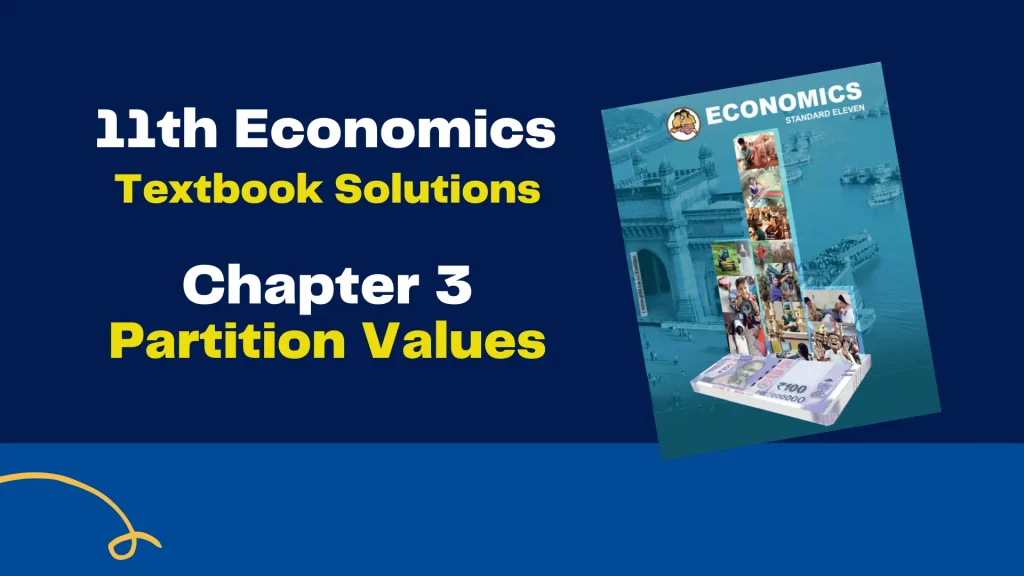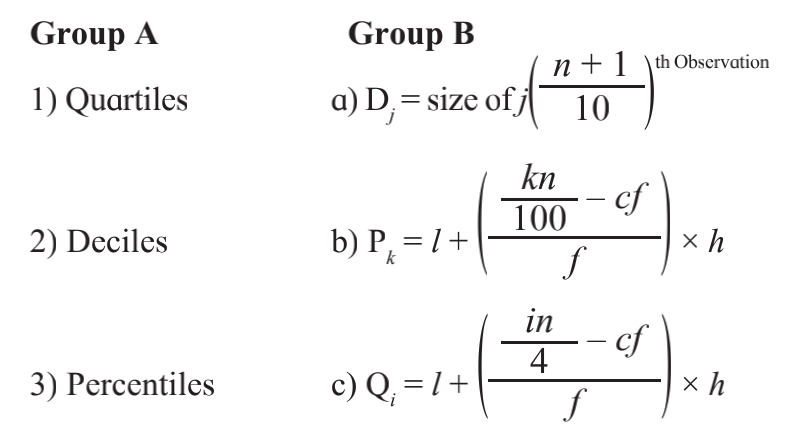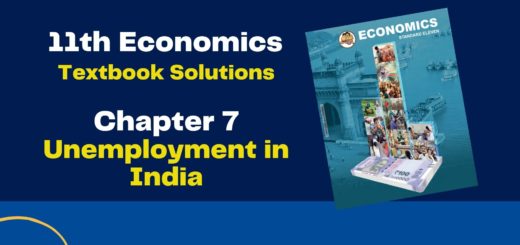11th Economics Chapter 3 Exercise Answers (Partition Values) Maharashtra Board – Free Solution
Table of Contents
11th Economics Chapter 3 Exercise

Chapter 3 – Partition Values
Q. 1. Choose the correct option
1) Statements that do not apply to Quartiles.
a) First arrange the values in ascending or descending order.
b) Observation can be divided into 4 parts.
c) They are represented as Q1, Q2, and Q3
d) Q2 is also known as median.
Options:
1) a
2) b and c
3) a, b and c
4) None of these
2) D7 from the given data.
Data – 4, 5, 6, 7, 8, 9, 10, 11, 12
Options:
1) 7
2) 9
3) 10
4) 12
3) Statements related to partition values that are correct.
a) Exact divisions of percentiles into 100 parts gives 99 points
b) Deciles have total 9 parts
c) Quartiles are shown by Q1, Q2, and Q3
d) Symbolically, Percentiles and Deciles are shown by P and D
Options:
1) a and c
2) a and b
3) a, b and c
4) a, c and d
Q. 2. Identify the correct pairs from the given options

Options :
1) 1-b, 2-c, 3-a
2) 1- c, 2-a, 3-b
3) 1- c, 2-b, 3-a
4) 1- a, 2-b, 3-c
Q. 3. Give economic terms
1) Procedure for dividing the data into equal parts. – (Partitioning)
2) Value that divides the series into ten equal parts. – (Deciles)
3) Value that divides the whole set of observations into four equal parts. – (Quartiles)
Q. 4. Solve the following
1) Calculate Q1, D4 and P26 for the following data.
18, 24, 45, 29, 4, 7, 28, 49, 16, 26, 25, 12, 10, 9, 8
2) Calculate Q3, D5, and P35 for the given data.
| Income (in lakhs Rs) | 1 | 2 | 3 | 4 | 5 | 6 |
| No. of family | 2 | 5 | 20 | 25 | 15 | 12 |
3) Find out P50 for the following data.
| Wages (in Rs) (x) | Number of workers |
| 0-20 | 4 |
| 20-40 | 6 |
| 40-60 | 10 |
| 60-80 | 25 |
| 80-100 | 15 |
4) Calculate Q3 for the following data.
| Sales (in lakhs Rs) | 10-20 | 20-30 | 30-40 | 40-50 | 50-60 | 60-70 |
| No. of family | 20 | 30 | 70 | 48 | 32 | 50 |
5) Calculate D7 for the following data.
| Profit (in crores Rs) | 10-20 | 20-30 | 30-40 | 40-50 | 50-60 | 60-70 |
| No. of family | 20 | 30 | 70 | 48 | 32 | 50 |
6) Calculate P15 for the following data.
| Profit (in crores Rs) | 0-10 | 10-20 | 20-30 | 30-40 | 40-50 | 50-60 |
| No. of family | 5 | 10 | 25 | 30 | 20 | 10 |
Solution of other subjects
Solution of all Chapters of Economics
1 – 2– 3 – 4 – 5 – 6 – 7 – 8 – 9 – 10
Q.5. State with reasons whether you agree or disagree with the following statements
1) Partition values have application only in theory but not in practice.
Answer: No, I disagree with this statement.
Reasons: a) Partition values like quartiles, deciles, and percentiles divide the given set of observations into an equal number of parts. So they have applications in theory.
b) Quartiles are used in the study of all types of financial information concerning economic data, income data, stock data, etc.
c) Government uses deciles to study the level of economic inequality, measurement of poverty line, drought conditions, etc.
d) Percentiles are used in the measurement of test scores, health indicators, household income, household wealth, and percentile wages.
Thus, partition values have applications in theory as well as in practice.
2) Average can misinterpret the representative value.
Answer: Yes, I agree with this statement.
Reasons: a) The arithmetic mean, mode and median are the types of averages that have certain limitations.
b) The data consists of extreme values on the lower side and also on the higher side in magnitude. Such values are known as ‘outliers’.
c) The average used for such data often misinterprets its representative value.
d) To overcome this misinterpretation, generally, partition values like median, quartiles, deciles, and percentiles are used.
Thus, the average can misinterpret the representative value.
3) Median is also known as second quartile.
Answer: Yes, I agree with this statement.
Reasons: a) Median divide the whole set of observations into two equal parts.
b) Quartiles divide the whole set of observations into four equal parts.
c) Therefore, the value of the median is equal to the second quartile.
Thus, the median is also known as the second quartile.
Solution of other subjects
Solution of all Chapters of Economics
1 – 2– 3 – 4 – 5 – 6 – 7 – 8 – 9 – 10
Q.6. Answer the following questions on the basis of the following table
| Marks | 20 | 10 | 20 | 40 | 50 |
| No. of Students | 13 | 4 | 7 | 8 | 6 |
1) Write the formula of Q1 and Q3 .
2) Find out the median of the above data?
3) Find out the cumulative frequency of the last value in the above data.
4) Find out the value of ‘n’ in the above data.
Solution of all Chapters of Economics
| Chapter Name | Solution Link |
| 1) Basic Concepts in Economics | Solution |
| 2) Money | Solution |
| 3) Partition Values | Solution |
| 4) The Economy of Maharashtra | Solution |
| 5) Rural Development in India | Solution |
| 6) Population in India | Solution |
| 7) Unemployment in India | Solution |
| 8) Poverty in India | Solution |
| 9) Economic Policy of India Since 1991 | Solution |
| 10) Economic Planning in India | Solution |
Check out other posts related to 11th Commerce
| Textbook Solutions of 11th Commerce (All Subjects) | Click Here |
| Free pdf of 11th Commerce Textbooks | Click Here |



Thank you
You are Most welcome.